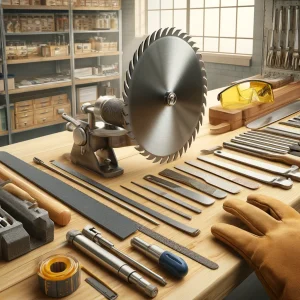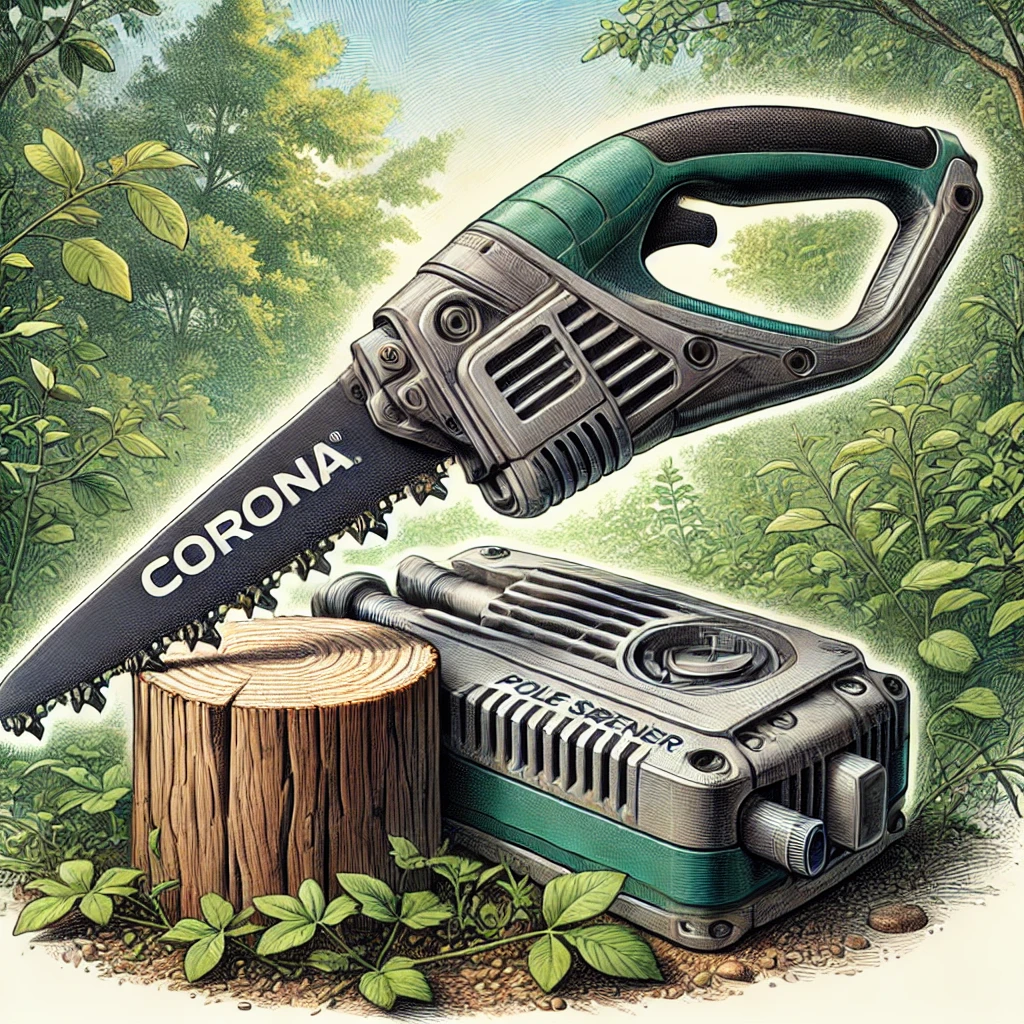Keeping your Corona Pole Saw Blade Sharpener is essential for efficient cutting and maintaining the longevity of your tool. In this complete guide, we’ll walk you through the steps, tools, and tips you need to sharpen your Corona Pole Saw Blade Sharpener like a pro. Whether you’re pruning branches or tackling overgrown trees, a sharp blade ensures precision and reduces fatigue.
Table of Contents
Why Is Sharpening Your Corona Pole Saw Blade Important?
Over time, frequent use can dull your Corona Pole Saw Blade Sharpener, resulting in:
- Inefficient Cutting: A dull blade requires more effort and time to cut.
- Damage to Trees: Dull blades cause rough cuts, which can harm tree health.
- Increased Wear and Tear: More force on the tool increases strain on both the blade and the operator.
Regular maintenance, including sharpening, ensures:
- Cleaner cuts
- Prolonged blade life
- Safer and smoother operation
Pros
Cons
Tools Needed to Sharpen Your Corona Pole Saw Blade

Before you start, gather these essential tools:
- File or Diamond Sharpener: Choose a round or flat file suitable for your blade’s teeth.
- Clamp or Vice: Secure the blade in place for stability.
- Gloves and Safety Goggles: Protect your hands and eyes during the process.
- Cleaning Supplies: Use a stiff brush and mild detergent to remove debris before sharpening.
- Lubricant: Light oil to reduce friction and protect the blade post-sharpening.
Step-by-Step Guide to Corona Pole Saw Blade Sharpener
- Clean the Blade
- Use a stiff brush to remove dirt, sap, and debris.
- Soak the blade in warm, soapy water if necessary, and dry it thoroughly before sharpening.
- Secure the Blade
- Place the pole saw blade in a vice or clamp to hold it steady. This prevents accidents and ensures accurate sharpening.
- Inspect the Blade
- Look for damaged or bent teeth. Straighten bent teeth with pliers or replace the blade if it’s excessively worn.
- File the Teeth
- Identify the beveled edge of each tooth.
- Using a round file, stroke each tooth along its bevel in the direction of the cut.
- Apply even pressure and maintain the original angle of the blade’s teeth (typically 30–35 degrees).
- Alternate Sides
- After sharpening one side of the blade, flip it to sharpen the opposite side. This keeps the blade balanced and effective.
- Test the Blade
- After sharpening, test the blade on a small branch. It should cut cleanly with minimal effort.
- Apply Lubricant
- Use light oil to coat the blade. This prevents rust and ensures smooth operation.
Tips for Maintaining Your Corona Pole Saw Blade
- Regular Sharpening: Sharpen the blade after every 10–15 uses or when you notice reduced cutting efficiency.
- Proper Storage: Store your pole saw in a dry place to prevent rust.
- Replace When Needed: If sharpening no longer improves performance, it’s time to replace the blade.
- Avoid Hitting Hard Surfaces: Steer clear of rocks or hard objects to prevent unnecessary damage.
Common Mistakes to Avoid
- Using the Wrong File: Always match the file size to the blade’s tooth size.
- Over-sharpening: Excessive filing can weaken the teeth.
- Ignoring Rust: Always remove rust before sharpening for better results.
- Rushing the Process: Take your time to ensure precision and accuracy.
Manual Pole Saws vs. Electric Saws: Finding the Perfect Tool for the Job

Choosing the right Corona Pole Saw Blade Sharpener for your tree-trimming and pruning tasks can be overwhelming, especially with so many options available. Two popular choices are manual pole saws and electric pole saws. Each type has its strengths and ideal use cases, making it crucial to understand their differences before investing in the perfect tool.
In this guide, we’ll break down the features, benefits, and drawbacks of both manual and electric pole saws, helping you find the tool that best suits your needs.
What Is a Manual Pole Saw?
A manual pole saw is a straightforward tool featuring a long pole with a Corona Pole Saw Blade Sharpener attached at the end. It relies on your physical effort to cut through branches.
Key Features:
- Lightweight design for easy handling.
- No need for power sources like electricity or batteries.
- Durable and easy to maintain.
Advantages of Manual Pole Saws:
- Affordable: Manual pole saws are budget-friendly compared to their electric counterparts.
- Quiet Operation: They produce no noise, making them ideal for use in quiet neighborhoods or early mornings.
- Low Maintenance: With no motor or electrical components, maintenance is minimal.
- Precision Cutting: Ideal for small to medium branches, providing clean and accurate cuts.
Disadvantages:
- Requires physical strength and effort.
- Not suitable for thick or high branches.
- Can be time-consuming for larger jobs.
What Is an Electric Pole Saw?
An electric pole saw is powered by electricity, either through a corded connection or a rechargeable battery. It comes equipped with a motorized chain saw at the end of the pole.
Key Features:
- Available in corded and cordless (battery-powered) models.
- Motorized cutting for efficient trimming.
- Lightweight designs, especially in cordless models.
Advantages of Electric Pole Saws:
- Effortless Cutting: The motor handles the cutting, reducing physical strain.
- Versatility: Handles small, medium, and some large branches with ease.
- Speed: Cuts through branches faster than manual saws.
- Extended Reach: Poles can extend to reach higher branches effectively.
Disadvantages:
- Corded Models: Limited by the length of the power cord.
- Cordless Models: Battery life may restrict usage time.
- Requires regular maintenance, such as chain oiling and sharpening.
- More expensive upfront cost compared to manual saws.
Comparison: Manual Pole Saws vs. Electric Saws

| Feature | Manual Pole Saw | Electric Pole Saw |
| Power Source | Human effort | Electricity (corded or cordless) |
| Ease of Use | Physically demanding | Easy, motorized operation |
| Ideal For | Light trimming, precise pruning | Large-scale tasks, thick branches |
| Maintenance | Minimal | Regular (e.g., oiling, cleaning) |
| Noise Level | Silent | Moderate (motor noise) |
| Cost | Affordable | Higher upfront cost |
When to Choose a Manual Pole Saw
Manual pole saws are the perfect choice if:
- You have light pruning tasks and thinner branches to cut.
- You want a low-cost, low-maintenance tool.
- You’re working in noise-sensitive areas.
- You enjoy the precision and control of manual tools.
Best Use Cases:
- Shaping ornamental trees.
- Cutting small branches around your garden.
- Occasional pruning needs.
When to Choose an Electric Pole Saw
Electric pole saws are ideal for:
- Tackling thick branches and heavier workloads.
- Frequent or large-scale pruning tasks.
- Reaching higher branches without physical strain.
- Saving time and effort during tree maintenance.
Best Use Cases:
- Clearing overgrown trees and shrubs.
- Professional landscaping jobs.
- Regular pruning of large properties.
NLP Keywords for Pole Saw Selection
- Manual pole saw advantages: Why choose a manual pole saw?
- Electric pole saw benefits: What makes electric saws better?
- Corded vs cordless pole saws: Which is more effective?
- Best pole saw for thick branches: Top tool recommendations.
- Tree pruning tools comparison: Manual vs electric pole saws.
You may also like
Which One Should You Choose?
The choice between a manual pole saw and an electric pole saw ultimately depends on your specific needs, budget, and workload. Here’s a quick decision guide:
- Opt for a manual pole saw if you need a lightweight, budget-friendly tool for occasional pruning of small branches.
- Choose an electric pole saw if you want a powerful, efficient tool to handle frequent or heavy-duty pruning tasks.
FAQs About Corona Pole Saw Blade Sharpening
1. How often should I sharpen my pole saw blade?
- Sharpen the blade after 10–15 uses or when you notice dull cuts.
2. Can I sharpen a rusty blade?
- Yes, but clean and remove the rust first to avoid damaging the teeth.
3. Should I replace the blade if it’s bent?
- Slight bends can be corrected with pliers, but severe damage warrants a replacement.
Conclusion
Sharpening your Corona Pole Saw Blade Sharpener doesn’t have to be daunting. With the right tools and techniques, you can keep your saw in top condition for years to come. Regular maintenance not only enhances performance but also ensures safer and more enjoyable pruning sessions.
By following this complete guide, you’ll achieve sharpening success and make the most out of your Corona pole saw. Remember, a well-maintained blade is the key to efficient and precise cutting!



Leave a Reply